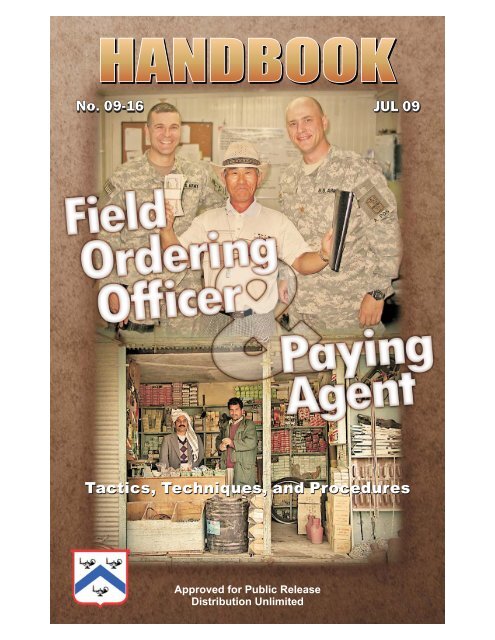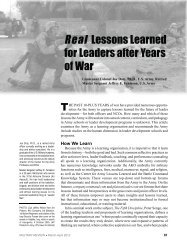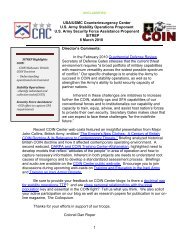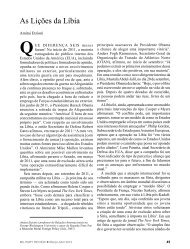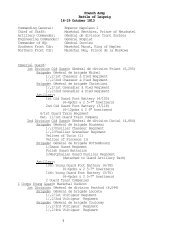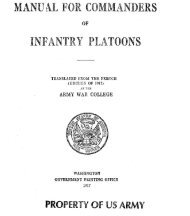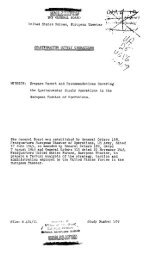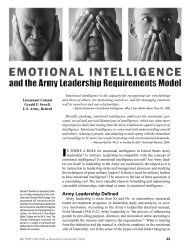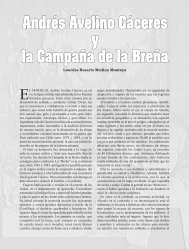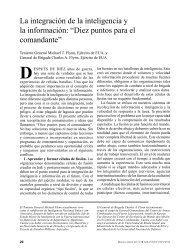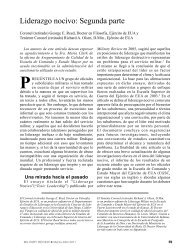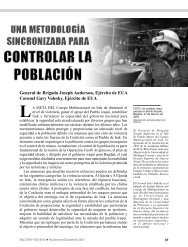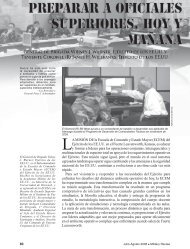Field Ordering Officer and Paying Agent Handbook - US Army ...
Field Ordering Officer and Paying Agent Handbook - US Army ...
Field Ordering Officer and Paying Agent Handbook - US Army ...
You also want an ePaper? Increase the reach of your titles
YUMPU automatically turns print PDFs into web optimized ePapers that Google loves.
HANDBOOK<br />
No. 09-16<br />
JUL 09<br />
Tactics, Techniques, <strong>and</strong> Procedures<br />
Approved for Public Release<br />
Distribution Unlimited
Foreword<br />
This h<strong>and</strong>book addresses the roles <strong>and</strong> functions of Soldiers performing as field ordering<br />
officers (FOOs) <strong>and</strong> paying agents. The <strong>Army</strong> relies on contracts for equipment, supplies,<br />
<strong>and</strong> services. Most contracts are not million- or multi-million-dollar programs that receive<br />
multiple levels of review. Most procurements are small “micro-purchases” units use to<br />
meet one-time, immediate needs. However, the basic st<strong>and</strong>ards of ethics <strong>and</strong> business<br />
practices for large programs also apply to micro-purchases. This h<strong>and</strong>book provides many<br />
basic st<strong>and</strong>ards <strong>and</strong> serves as a ready reference for FOOs <strong>and</strong> paying agents while they<br />
support their units’ requirements.<br />
Key lessons:<br />
FIELD ORDERING OFFICER AND PAYING AGENT HANDBOOK<br />
FOOs <strong>and</strong> paying agents must work closely together, but they are not alone.<br />
They are part of an acquisition team that includes the contract <strong>and</strong> financial<br />
management experts who will provide the guidance <strong>and</strong> direction to each FOO<br />
<strong>and</strong> paying agent to meet the unit’s needs.<br />
While performing as FOOs or paying agents, Soldiers work for <strong>and</strong> must<br />
respond to guidance from the chief of contracting who appointed them.<br />
A FOO cannot be a paying agent. Likewise, a paying agent cannot be a FOO.<br />
Neither one can act as a property book officer or property accountable officer.<br />
FOOs <strong>and</strong> paying agents must be careful when dealing with local nationals.<br />
Because FOOs <strong>and</strong> paying agents have a ready source of cash, local nationals<br />
may overestimate the influence of FOO <strong>and</strong> paying agent teams.<br />
Issues that get FOOs <strong>and</strong> paying agents in trouble include security (personal <strong>and</strong><br />
cash); unauthorized purchases (the kind of purchase, the number of items<br />
purchased, or the single item or extended dollar amount); split purchases to get<br />
around limits; poor record keeping (which can cost FOOs <strong>and</strong> paying agents a<br />
lot of money); gifts (of any kind); <strong>and</strong> accepting <strong>and</strong> not reporting gifts.<br />
Approved for Public Release<br />
Distribution Unlimited<br />
i
FIELD ORDERING OFFICER AND PAYING AGENT HANDBOOK<br />
<strong>Field</strong> <strong>Ordering</strong> <strong>Officer</strong> <strong>and</strong> <strong>Paying</strong> <strong>Agent</strong> H<strong>and</strong>bookitle<br />
Table of Contents<br />
Preface 1<br />
Chapter 1: The Down <strong>and</strong> Dirty of <strong>Field</strong> <strong>Ordering</strong> <strong>Officer</strong>s <strong>and</strong><br />
<strong>Paying</strong> <strong>Agent</strong>s on the Battlefield<br />
Chapter 2: The Acquisition Team 5<br />
Chapter 3: Duties 7<br />
Chapter 4: Training 9<br />
Chapter 5: Establishing an Account 11<br />
Chapter 6: Conduct <strong>and</strong> St<strong>and</strong>ards 13<br />
Chapter 7: Maintaining Files 15<br />
Chapter 8: Making a Purchase 17<br />
Chapter 9: Security 25<br />
Chapter 10: Inspections, Clearance, <strong>and</strong> Termination 27<br />
Chapter 11: Beyond the Basics: Tips <strong>and</strong> Tricks 31<br />
Appendix A: St<strong>and</strong>ard Form 44 (blank) 35<br />
Appendix B: St<strong>and</strong>ard Form 44 (completed sample) 37<br />
Appendix C: Ledger Example 39<br />
Appendix D: Department of <strong>Army</strong> Form 3953 (completed sample) 41<br />
Appendix E: Metric Conversions 43<br />
Appendix F: Acquisition Team Point of Contact Reference 45<br />
Appendix G: Example of a <strong>Field</strong> <strong>Ordering</strong> <strong>Officer</strong> Appointment<br />
Letter/Order<br />
Appendix H. Common Terms <strong>and</strong> Acronyms 51<br />
Approved for Public Release<br />
Distribution Unlimited<br />
3<br />
49<br />
iii
CENTER FOR ARMY LESSONS LEARNED<br />
Center for <strong>Army</strong> Lessons Learned<br />
Director Colonel Robert W. Forrester<br />
Branch Chief David Bialas<br />
CALL Analyst John Goodloe<br />
Contributing Author LTC Mark Stone<br />
Production Coordinator Valerie Tystad<br />
Editor Patricia McAllister<br />
Graphic Artist Dan Neal<br />
Distribution Manager C<strong>and</strong>ice Miller<br />
The Secretary of the <strong>Army</strong> has determined that the publication of this periodical is<br />
necessary in the transaction of the public business as required by law of the<br />
Department.<br />
Unless otherwise stated, whenever the masculine or feminine gender is used, both<br />
are intended.<br />
Note: Any publications (other than CALL publications) referenced in this product,<br />
such as ARs, FMs, <strong>and</strong> TMs, must be obtained through your pinpoint distribution<br />
system.<br />
iv<br />
Approved for Public Release<br />
Distribution Unlimited
FIELD ORDERING OFFICER AND PAYING AGENT HANDBOOK<br />
Preface<br />
This first edition of the Battlefield <strong>Field</strong> <strong>Ordering</strong> <strong>Officer</strong> <strong>and</strong> <strong>Paying</strong> <strong>Agent</strong><br />
H<strong>and</strong>book contains a summary of acquisition policies, procedures, <strong>and</strong> managerial<br />
skills field ordering officers (FOOs)* <strong>and</strong> paying agents frequently require in<br />
deployed environments. FOOs <strong>and</strong> paying agents operating in deployed<br />
environments face realities not found in operations in the continental United States.<br />
The authors extracted the information in this h<strong>and</strong>book from numerous sources<br />
within the defense acquisition community <strong>and</strong> hard lessons learned from countless<br />
FOOs, paying agents, <strong>and</strong> contingency contracting officers in deployed<br />
environments.<br />
The h<strong>and</strong>book’s design allows readers to begin reading at any point, so start with a<br />
topic that interests you. You can use the table of contents to identify general areas<br />
of interest <strong>and</strong> find what you need. Place the h<strong>and</strong>book in your uniform’s cargo<br />
pocket, <strong>and</strong> tackle any FOO or paying agent task with confidence.<br />
This h<strong>and</strong>book is the second in a series of five h<strong>and</strong>books produced by the office of<br />
the Assistant Secretary of the <strong>Army</strong> (Acquisition, Logistics, <strong>and</strong> Technology)<br />
Integration Office (ALT-IO) <strong>and</strong> the U.S. <strong>Army</strong> Combined Arms Center (via the<br />
Center for <strong>Army</strong> Lessons Learned) in response to the U.S. <strong>Army</strong> Combined Arms<br />
Support Comm<strong>and</strong>’s (CASCOM) operational contract support gap mitigation<br />
strategy. Remember, this h<strong>and</strong>book is only a guide <strong>and</strong> should not be used as a<br />
substitute for official policy <strong>and</strong> training. Your supporting contracting officer<br />
provides actual training to FOOs; your local disbursing officer provides training to<br />
paying agents.<br />
The approving authority for this h<strong>and</strong>book is the CASCOM comm<strong>and</strong>ing general.<br />
The technical review authority is the HQ U.S. <strong>Army</strong> Materiel Comm<strong>and</strong>. Send<br />
comments <strong>and</strong> recommendations on Department of the <strong>Army</strong> Form 2028,<br />
Recommendation Changes to Publications <strong>and</strong> Blank Forms, to: Comm<strong>and</strong>er, U.S.<br />
CASCOM, ATTN: ATCL-ALT-IO, 3901 A Avenue, Suite 137, Fort Lee, VA,<br />
23801-1899.<br />
* Note: The term field ordering officer is a recognized term by the Defense<br />
Acquisition University <strong>and</strong> the Joint Staff J4 <strong>and</strong> is synonymous with ordering<br />
officer as described in the <strong>Army</strong> Federal Acquisition Regulation Supplement<br />
(AFARS) 5101.602-2-90.<br />
Approved for Public Release<br />
Distribution Unlimited<br />
1
CENTER FOR ARMY LESSONS LEARNED<br />
2<br />
Figure P-1. Contracted transport gets ready for a mission<br />
Approved for Public Release<br />
Distribution Unlimited
Introduction<br />
FIELD ORDERING OFFICER AND PAYING AGENT HANDBOOK<br />
Chapter 1<br />
The Down <strong>and</strong> Dirty of <strong>Field</strong> <strong>Ordering</strong> <strong>Officer</strong>s<br />
<strong>and</strong> <strong>Paying</strong> <strong>Agent</strong>s on the Battlefield<br />
Perhaps your comm<strong>and</strong>er recently selected you as a field ordering officer (FOO) or<br />
paying agent, <strong>and</strong> you are wondering how you are going to accomplish either of<br />
these missions. The first thing you must do is complete the training that your<br />
supporting contracting office (for FOOs) or disbursing office (for paying agents)<br />
requires. This h<strong>and</strong>book provides the basic tools <strong>and</strong> knowledge to use in<br />
conjunction with the formal training. Contracting is a highly regulated process with<br />
many traps for unsuspecting FOOs <strong>and</strong> paying agents, so be careful.<br />
The Importance of Contracting on the Battlefield<br />
In some form or another, contractors have been part of the battlefield since the<br />
American Revolution. General George Washington used civilian wagon drivers to<br />
haul military supplies. Over time, contracting support evolved from an ad hoc,<br />
add-on capability to an essential, vital part of force projection capability.<br />
Contractors, including vendors for very small purchases, are a force multiplier, <strong>and</strong><br />
the <strong>Army</strong> relies on their support for just about every mission. The key is ensuring<br />
contractors follow the contract requirements. FOOs <strong>and</strong> paying agents play critical<br />
roles.<br />
Comm<strong>and</strong>ers establish <strong>and</strong> use FOOs to make over-the-counter purchases in<br />
amounts up to the micro-purchase threshold (check with your supporting<br />
contracting office to find out the FOO purchase threshold). As a part of the<br />
FOO/paying agent team, you will provide your comm<strong>and</strong>er with the ability to make<br />
local purchases, quickly <strong>and</strong> directly, to support the comm<strong>and</strong>er’s (your unit’s)<br />
mission.<br />
Figure 1-1. Future FOOs undergo training<br />
Approved for Public Release<br />
Distribution Unlimited<br />
3
CENTER FOR ARMY LESSONS LEARNED<br />
Keep in mind there are several players involved in field ordering operations besides<br />
FOOs <strong>and</strong> paying agents. The financial management or disbursing office, resource<br />
management office, supporting contracting office, <strong>and</strong> the unit comm<strong>and</strong>er are all<br />
part of the “acquisition team” that enables this program. Successfully navigating<br />
through a maze of personnel <strong>and</strong> bureaucracy can be a daunting task. Patience,<br />
flexibility, <strong>and</strong> creativity are required to reach the ultimate goal of supporting<br />
Soldiers.<br />
The following list includes just a few of the challenges FOOs/paying agents may<br />
encounter:<br />
4<br />
Corruption (number one threat)<br />
Customs <strong>and</strong> culture differences<br />
Trafficking in persons<br />
Enemy threats against vendors<br />
Information security <strong>and</strong> operations security (vendors can provide<br />
intelligence to the enemy)<br />
Language barriers<br />
Time-management challenges<br />
Unauthorized commitments by you or by someone speaking for you<br />
Chain of comm<strong>and</strong> <strong>and</strong> conflicting responsibilities<br />
Contingency/combat environment<br />
Approved for Public Release<br />
Distribution Unlimited
FIELD ORDERING OFFICER AND PAYING AGENT HANDBOOK<br />
Chapter 2<br />
The Acquisition Team<br />
The acquisition team consists of all participants in the acquisition process, such as<br />
the requiring activity (your unit), financial management (FM), the contracting<br />
officer, the field ordering officer (FOO)/paying agent team, <strong>and</strong> others. This brief<br />
overview examines the roles of team members <strong>and</strong> notes how important it is to<br />
work together in order to stay on target. Successful teams assign each team member<br />
specific duties, establish performance measures <strong>and</strong> milestones for comm<strong>and</strong>ers<br />
<strong>and</strong> team leaders, <strong>and</strong> have comm<strong>and</strong>ers that hold members individually <strong>and</strong><br />
collectively accountable.<br />
The Basic Acquisition Team<br />
Requiring activity<br />
The requiring activity is the <strong>Army</strong> unit that has a requirement for goods or services<br />
<strong>and</strong> requested the initiation of the requirement. The FOO routinely interfaces with<br />
the requiring activity (most likely his own unit), the contractor, <strong>and</strong> the contracting<br />
officer.<br />
Financial management<br />
The ultimate mission of your supporting FM detachment is to sustain the combat<br />
Soldiers <strong>and</strong> comm<strong>and</strong>ers in the field with timely <strong>and</strong> accurate financial <strong>and</strong><br />
accounting support. This support includes processing military <strong>and</strong> civilian pay,<br />
preparing travel <strong>and</strong> paying travel expenses, managing transportation <strong>and</strong><br />
commercial vendor vouchers, <strong>and</strong> accounting for the obligation <strong>and</strong> disbursement<br />
of public funds. As a paying agent, you will routinely interface with FM.<br />
Resource manager<br />
The resource manager (RM) is the principal advisor to the comm<strong>and</strong>er on FM. The<br />
RM is responsible for developing comm<strong>and</strong> resource requirements, identifying<br />
sources of funding, determining costs, acquiring funds, distributing <strong>and</strong> controlling<br />
funds, <strong>and</strong> tracking costs <strong>and</strong> obligations.<br />
Contracting officer<br />
Normally, leadership of the acquisition team comes from the contracting officer.<br />
The contracting officer is the only individual expressly authorized to enter into,<br />
administer, <strong>and</strong>/or terminate contracts. Contracting officers are responsible for<br />
ensuring all contract actions comply with appropriate laws, executive orders,<br />
regulations, <strong>and</strong> other applicable procedures <strong>and</strong> approvals.<br />
A successful FOO/paying agent team depends on a successful acquisition team.<br />
Key framework for a successful team includes:<br />
Partnership.<br />
Informed decisions.<br />
Sound planning.<br />
Efficient execution.<br />
Approved for Public Release<br />
Distribution Unlimited<br />
5
CENTER FOR ARMY LESSONS LEARNED<br />
It is a good idea for each FOO <strong>and</strong> paying agent to know the names, phone<br />
numbers, <strong>and</strong> e-mail addresses of all acquisition team members. See Appendix F for<br />
an example of an acquisition team point of contact reference template.<br />
6<br />
Approved for Public Release<br />
Distribution Unlimited
FIELD ORDERING OFFICER AND PAYING AGENT HANDBOOK<br />
<strong>Field</strong> <strong>Ordering</strong> <strong>Officer</strong><br />
Chapter 3<br />
Duties<br />
The supporting contracting officer appoints a field ordering officer (FOO) in<br />
accordance with <strong>Army</strong> Federal Acquisition Regulation Supplement (AFARS)<br />
5153.9002. This appointment delegates the contracting officer’s authority to<br />
obligate the government for micro-purchases (check with your supporting<br />
contracting officer for current purchase thresholds) for supplies <strong>and</strong> limited<br />
services. This appointment also eases the administrative burden on a unit <strong>and</strong> its<br />
supporting contracting office (<strong>and</strong> vendors) by eliminating lengthy contracting<br />
procedures for small purchases. See Appendix G for an example of a FOO<br />
appointment letter/order.<br />
<strong>Paying</strong> <strong>Agent</strong> (formerly known as Class A <strong>Agent</strong>)<br />
<strong>Paying</strong> agents make specific payments. The disbursing officer within a supporting<br />
financial management (FM) unit appoints Soldiers to the position of paying agent.<br />
Each paying agent is under the exclusive supervision of the disbursing officer in all<br />
matters concerning custody <strong>and</strong> disposition of funds advanced to the paying agent.<br />
The paying agent will comply with all instructions <strong>and</strong> regulations the disbursing<br />
officer issues pertaining to paying agent duties. Each paying agent holds the funds<br />
advanced to him at personal risk. The paying agent must account for those<br />
advanced funds to the disbursing officer immediately upon completion of the<br />
transaction(s).<br />
FOOs negotiate with vendors for goods <strong>and</strong>/or services to meet the needs of the<br />
requiring activity, <strong>and</strong> the paying agents make the payment to the vendor, then<br />
safeguard <strong>and</strong> account for cash <strong>and</strong>/or payment documents. Separating duties in this<br />
manner protects against errors, theft, <strong>and</strong> fraud.<br />
Reminder: A FOO may not hold the additional duty of paying agent, property book<br />
officer, or property accountable officer. Likewise, a paying agent may not hold the<br />
additional duty of a FOO, property book officer, or property accountable officer.<br />
Comm<strong>and</strong>ers cannot delegate the duties of FOOs or paying agents. It is imperative<br />
that the individual nominated be the one performing the duties until he has properly<br />
cleared the contracting office (FOO) or disbursing office (paying agent) or is<br />
terminated for whatever reason. It is a good idea to have an alternate trained FOO<br />
<strong>and</strong> paying agent as a st<strong>and</strong>by if the primary person is unable perform his assigned<br />
duties.<br />
Approved for Public Release<br />
Distribution Unlimited<br />
7
FIELD ORDERING OFFICER AND PAYING AGENT HANDBOOK<br />
Chapter 4<br />
Training<br />
It is a best practice for each field ordering officer (FOO) <strong>and</strong> paying agent to attend<br />
both the FOO <strong>and</strong> paying agent training to learn the roles <strong>and</strong> responsibilities of<br />
each person on the team. This practice will minimize confusion between the two<br />
individuals. Normally, each training session will last about one hour. Check with<br />
your supporting contracting office <strong>and</strong> disbursing unit to schedule the training.<br />
Upon completion of training, the contracting officer appoints the FOO. Upon<br />
appointment, the FOO will add to his files the FOO appointment order signed by<br />
the contracting officer <strong>and</strong>, if applicable, the written special instructions provided<br />
by the contracting officer.<br />
After the contracting officer authorizes the FOO to make purchases, the contracting<br />
officer will issue the purchase order book (St<strong>and</strong>ard Form [SF] 44, Purchase<br />
Order–Invoice–Voucher) to the FOO. The contracting officer will usually issue the<br />
SF 44 electronically as a Microsoft Word document.<br />
Refresher training will occur every six months or whenever the contracting officer<br />
deems necessary. Refresher training may occur in person or by other sufficient<br />
means if the FOO <strong>and</strong> the chief of the contracting office are not in the same<br />
location.<br />
Reminder: A FOO may not hold the additional duty of a paying agent, property<br />
book officer, or property accountable officer. Likewise, a paying agent may not<br />
hold the additional duty of a FOO, property book officer, or property accountable<br />
officer.<br />
Comm<strong>and</strong>ers must underst<strong>and</strong> they cannot delegate the duties of FOOs or paying<br />
agents. The individual nominated to the position must perform the duties of the<br />
position until he properly clears the contracting office (FOO) or disbursing unit<br />
(paying agent) or is terminated for whatever reason. It is a good idea to have an<br />
alternate trained FOO <strong>and</strong> paying agent as a st<strong>and</strong>by if the primary person is unable<br />
perform his assigned duties.<br />
Approved for Public Release<br />
Distribution Unlimited<br />
9
FIELD ORDERING OFFICER AND PAYING AGENT HANDBOOK<br />
Chapter 5<br />
Establishing an Account<br />
The field ordering officer (FOO) <strong>and</strong> paying agent must be together when opening a<br />
new account.<br />
At a minimum, the following documents are needed:<br />
Nomination memor<strong>and</strong>um from a lieutenant colonel (O5) within the chain<br />
of comm<strong>and</strong>.<br />
FOO appointment orders signed by contracting officer.<br />
<strong>Paying</strong> agent appointment orders (see financial management [FM] for the<br />
requirements of this document).<br />
Department of the <strong>Army</strong> (DA) Form 3953, Purchase Request <strong>and</strong><br />
Commitment, with accounting classification approved <strong>and</strong> signed by the<br />
appropriate resource manager.<br />
DA Form 577, Appointment/Termination Record (signature cards for both<br />
the FOO <strong>and</strong> paying agent).<br />
Protecting Funds Under <strong>Field</strong> Conditions<br />
All government funds must be under continuous control in the field. Under no<br />
circumstances will the paying agent leave funds unattended <strong>and</strong> unsecured. The<br />
deploying comm<strong>and</strong>er must establish <strong>and</strong> enforce procedures for protecting<br />
deployed government funds (e.g., field safe used solely for securing funds).<br />
Settlement of Account<br />
After the FOO mission is complete, the paying agent will terminate this account<br />
with the accounting <strong>and</strong> FM company comm<strong>and</strong>er. The paying agent will obtain a<br />
copy of Department of Defense Form 1081, Statement of <strong>Agent</strong> <strong>Officer</strong>’s Account,<br />
<strong>and</strong> show the account reduced to zero.<br />
Approved for Public Release<br />
Distribution Unlimited<br />
11
Chapter 6<br />
Conduct <strong>and</strong> St<strong>and</strong>ards<br />
<strong>Field</strong> ordering officers (FOOs) <strong>and</strong> paying agents must establish <strong>and</strong> maintain<br />
conduct <strong>and</strong> behavior above reproach. Therefore, FOOs <strong>and</strong> paying agents must<br />
avoid doing or appearing to do anything improper. Included in this prohibition are<br />
actions such as the following:<br />
Accepting anything of value (e.g., meals, baseball caps, coffee cups, pens,<br />
etc.).<br />
Making government purchases from a vendor with whom they have or<br />
appear to have a financial interest.<br />
Doing anything that might adversely affect the public’s confidence in the<br />
government’s integrity.<br />
Reference: Department of Defense Directive 5500.7-R, Joint Ethics Regulation.<br />
Fraud<br />
FIELD ORDERING OFFICER AND PAYING AGENT HANDBOOK<br />
Samuel Adams once said, “The public cannot be too curious concerning the<br />
characters of public men,” <strong>and</strong> Henry Clay added, “Government is a trust, <strong>and</strong> the<br />
officers of the government are trustees; <strong>and</strong> both the trust <strong>and</strong> the trustees are<br />
created for the benefit of the people.”<br />
Fraud is the intentional presentation of falsehoods as truth with the goal of causing<br />
someone to part with something of value under false pretenses. Violators can<br />
receive punishments of prison time from five to ten years <strong>and</strong>/or receive fines up to<br />
$250,000. Contracting <strong>and</strong> procurement fraud schemes involve:<br />
Product substitution.<br />
Defective pricing.<br />
Cost mischarging.<br />
Price fixing.<br />
Record fabrication.<br />
Bribes, gratuities, <strong>and</strong> kickbacks (common threats within deployed<br />
environments).<br />
Government employee collusion <strong>and</strong> individual fraud.<br />
FOOs <strong>and</strong> paying agents are not investigators <strong>and</strong> must not personally investigate<br />
suspected cases. Determine the facts of questionable circumstances <strong>and</strong><br />
occurrences, <strong>and</strong> advise the appropriate contracting officer, financial management<br />
company comm<strong>and</strong>er, comm<strong>and</strong>er, supervisor, or criminal investigative agency.<br />
Approved for Public Release<br />
Distribution Unlimited<br />
13
Chapter 7<br />
Maintaining Files<br />
<strong>Field</strong> ordering officers (FOOs) <strong>and</strong> paying agents are required to maintain adequate<br />
records as to duties during their appointments <strong>and</strong> to dispose of such records as the<br />
contracting officer (for the FOO) <strong>and</strong> financial management (FM) company<br />
comm<strong>and</strong>er (for the paying agent) directs. When it comes to h<strong>and</strong>ling cash <strong>and</strong><br />
obligating funds for the government, a lot of paper changes h<strong>and</strong>s. In order to<br />
establish control, careful documentation is very important. Do not forget about<br />
organization—be able to find that documentation if questions arise later.<br />
At a minimum, files must contain the following:<br />
Working File<br />
FIELD ORDERING OFFICER AND PAYING AGENT HANDBOOK<br />
A copy of the FOO appointment orders or letter from the contracting<br />
officer, a copy of any changes to the orders or letter, <strong>and</strong> a copy of any<br />
termination orders or letter.<br />
A copy of the paying agent appointment orders or letter from FM unit.<br />
DA Form 577, Appointment/Termination Record (signature cards for both<br />
the FOO <strong>and</strong> paying agent).<br />
A copy of Department of <strong>Army</strong> (DA) Form 3953, Purchase Request <strong>and</strong><br />
Commitment, providing funds for the paying agent.<br />
All correspondence concerning duties.<br />
Names <strong>and</strong> position titles of individuals on the acquisition team.<br />
Records of all purchases (St<strong>and</strong>ard Form [SF] 44s [Purchase<br />
Order–Invoice–Voucher], ledgers, <strong>and</strong> invoices).<br />
Memor<strong>and</strong>a for record (MFR) of any meetings <strong>and</strong> discussions with any<br />
contractor/vendor or others pertaining to purchases.<br />
Nomination memor<strong>and</strong>ums from the comm<strong>and</strong>er (lieutenant colonel or<br />
higher).<br />
Documentation of all ongoing clearance memos with contracting <strong>and</strong> FM.<br />
Pecuniary Liability Statement signed by paying agent issued by the<br />
disbursing officer.<br />
The working file is a part of the official file <strong>and</strong> must be maintained in accordance<br />
with the contracting officer’s instructions. The FOO should maintain the file.<br />
Further, the working file must be available for the review of the contracting officer,<br />
FM company comm<strong>and</strong>er or disbursing officer, or other authorized official.<br />
Observe the following practices:<br />
Approved for Public Release<br />
Distribution Unlimited<br />
15
CENTER FOR ARMY LESSONS LEARNED<br />
Prepare an MFR no later than one business day after a significant meeting<br />
or discussion with any contractor/vendor or the contracting officer.<br />
Include records of telephone conversations <strong>and</strong> trip reports.<br />
Clearly index all documents <strong>and</strong> files by group in chronological order in a<br />
suitable folder or as the contracting officer directs.<br />
Forward to the contracting officer any correspondence received from any<br />
contractor/vendor or any supported unit.<br />
Retain records that pertain to unsettled claims, open investigations, cases<br />
under litigation, or similar matters until final clearance or settlement.<br />
Destroy duplicate copies of file documents after they have served their<br />
purpose.<br />
Remember that e-mails are legal documents <strong>and</strong> should be maintained in<br />
your file.<br />
Maintain records for at least one year after termination of FOO duties.<br />
(Contracting office retains file for three years.)<br />
Note: If you discover you are missing files, contact your contracting officer.<br />
Remember you should receive your initial working file from your contracting<br />
officer during FOO training. The FOO file should be considered confidential <strong>and</strong><br />
safeguarded appropriately.<br />
The Resource Manager (RM), who certified the fund cite on DA Form 3953, is the<br />
official keeper of the files. The RM must maintain copies of all supporting<br />
documents for internal review audit purposes. It is the responsibility of the FOO to<br />
ensure the RM receives any supporting documents pertaining to the file to include<br />
SF 44s, clearing letters from contracting <strong>and</strong> the Installation Property Book Office,<br />
<strong>and</strong> Department of Defense Form 1081, Statement of <strong>Agent</strong> <strong>Officer</strong>’s Account.<br />
16<br />
Approved for Public Release<br />
Distribution Unlimited
FIELD ORDERING OFFICER AND PAYING AGENT HANDBOOK<br />
Chapter 8<br />
Making a Purchase<br />
Each field ordering officer (FOO) must maintain the following documents on file<br />
for every purchase:<br />
Request document from the unit requesting purchase of the item.<br />
St<strong>and</strong>ard Form (SF) 44, Purchase Order–Invoice–Voucher.<br />
Seller’s receipt (if possible).<br />
Ledger of all transactions.<br />
Documentation of any special approvals or description of special<br />
circumstances surrounding the purchase.<br />
Failure to obtain the above documents may result in the FOO not obtaining<br />
clearance for the purchase.<br />
All purchase requests must be in writing. Each purchase request must contain a<br />
clear <strong>and</strong> underst<strong>and</strong>able item description, a specific quantity, <strong>and</strong> a cost estimate.<br />
The requesting unit’s property book officer (PBO) must approve purchases of any<br />
items that are property book accountable.<br />
Tip: A best practice is for the requesting unit’s PBO to review <strong>and</strong> approve<br />
(including approvals by e-mail) all purchase requests to ensure the PBO is not left<br />
out of the loop for property book accountable items. This step may not be possible<br />
in all cases, but the FOO must establish <strong>and</strong> maintain close contacts with the PBOs<br />
of the units he supports.<br />
The FOO must ensure he has the authority to make purchases of each requested<br />
item or service in compliance with the letter of appointment/appointment orders<br />
from the contracting officer <strong>and</strong> any special instructions. The FOO also must ensure<br />
the paying agent has sufficient funds available for each purchase. As designated<br />
representatives of the chief of contracting, FOOs do not have authority to purchase<br />
supplies <strong>and</strong>/or services beyond the authority the chief of contracting establishes in<br />
their appointment orders or letters of appointment (FOOs must review their<br />
appointment letters).<br />
Approved for Public Release<br />
Distribution Unlimited<br />
17
CENTER FOR ARMY LESSONS LEARNED<br />
Figure 8-1. A FOO negotiates a purchase with a vendor<br />
The FOO <strong>and</strong> the paying agent will then locate a local source of supply or services<br />
to fulfill the request <strong>and</strong> obtain pricing for the item or service.<br />
The FOO then will make <strong>and</strong> record a determination of price reasonableness. If the<br />
price exceeds the single purchase authorization, the FOO will forward the<br />
requirement to the contracting office using Department of the <strong>Army</strong> (DA) Form<br />
3953, Purchase Request <strong>and</strong> Commitment.<br />
During discussions with contractors/vendors, the FOO must make it clear from the<br />
beginning that the FOO cannot accept gifts <strong>and</strong> money. However, bartering is part<br />
of every deal, <strong>and</strong> everything is negotiable.<br />
Expect vendors who have established relationships with FOOs <strong>and</strong> paying agents to<br />
offer gifts <strong>and</strong> money as a “cut” of the deal. This gesture is customary business<br />
practice <strong>and</strong> should not be seen as a bribe or other blight on the character of the<br />
vendor. Politely decline all offers/gifts.<br />
If the price is reasonable, the FOO <strong>and</strong> paying agent will complete their respective<br />
sections within the SF 44 <strong>and</strong> purchase the item (see sample SF 44s at Appendices<br />
A <strong>and</strong> B). The paying agent will execute payment at the time of purchase <strong>and</strong><br />
complete the SF 44.<br />
Remember that a completed SF 44 is equivalent to the monetary value of the cash it<br />
represents. If you lose a completed SF 44, you may lose that amount out of your<br />
leave <strong>and</strong> earnings statement (LES). Safeguard all completed SF 44s <strong>and</strong> make<br />
copies.<br />
18<br />
Approved for Public Release<br />
Distribution Unlimited
FIELD ORDERING OFFICER AND PAYING AGENT HANDBOOK<br />
Figure 8-2. A FOO closes a deal<br />
If possible, the FOO should obtain a purchase receipt from the seller <strong>and</strong> maintain<br />
the receipt on file as proof of purchase. If the vendor refuses to sign the SF 44,<br />
document the circumstances later <strong>and</strong> place that report on file with the purchase<br />
records but continue to finalize the purchase with the current vendor.<br />
Each FOO must maintain an obligation record annotating the following for each<br />
purchase:<br />
Purchase order number<br />
Name <strong>and</strong> location of the vendor<br />
Date of transaction<br />
Description of the item/service purchased<br />
Amount of obligation<br />
Balance of unobligated funds<br />
This information can be maintained on the reverse side of the DA Form 3953 or,<br />
more commonly, by a locally produced manual or automated ledger (see Appendix<br />
C for an example of a ledger). Remember, the ledger is the gr<strong>and</strong>daddy of the<br />
bookkeeping system. Draw on the ledger for account summaries to develop reports<br />
<strong>and</strong> to help make key business decisions. In addition, each FOO should consider<br />
computerizing the ledger to increase accuracy <strong>and</strong> to cut the time it takes to do<br />
bookkeeping—use automated spreadsheet software such as the widely available<br />
Excel component of the <strong>Army</strong> st<strong>and</strong>ard Microsoft Office Suite.<br />
At the end of each day of purchasing, the paying agent must “prove-out” or test the<br />
ledger <strong>and</strong> supporting documents. It is a big job, but a necessary one. Testing<br />
starts with counting cash. Why start with cash? Because the accounting process<br />
starts with transactions, <strong>and</strong> transactions occur when cash exchanges h<strong>and</strong>s for<br />
purchases. The ledger <strong>and</strong> SF 44s need to match the amount of cash you have on<br />
h<strong>and</strong>.<br />
Approved for Public Release<br />
Distribution Unlimited<br />
19
CENTER FOR ARMY LESSONS LEARNED<br />
If a purchase is made under unusual circumstances <strong>and</strong> special situations or is a<br />
regulated purchase, the FOO must document the date, description of circumstances,<br />
<strong>and</strong> any other relevant information that directly affected the procurement process.<br />
The rush to complete transactions <strong>and</strong> the stress level under which FOOs <strong>and</strong><br />
paying agents work can lead to confusing math <strong>and</strong> tracking problems. FOOs <strong>and</strong><br />
paying agents must use a system for managing the money. A checkbook-style<br />
ledger or money management software program is a crucial asset for a FOO team.<br />
The FOO <strong>and</strong> paying agent must check each other’s work constantly.<br />
The following chart depicts a generalized process as it relates responsibility of each<br />
member on the acquisition team:<br />
Figure 8-3. The FOO’s acquisition process<br />
Reminder: The paying agent must accompany the FOO when making any<br />
purchases. Only the FOO negotiates with vendors, <strong>and</strong> only the paying agent<br />
safeguards, disburses, <strong>and</strong> accounts for the funds.<br />
Tip: <strong>Army</strong> Federal Acquisition Regulation Supplement (AFARS) 5113.270-90<br />
dated 22 May 2007 authorizes government purchases from <strong>Army</strong> & Air Force<br />
20<br />
Approved for Public Release<br />
Distribution Unlimited
FIELD ORDERING OFFICER AND PAYING AGENT HANDBOOK<br />
Exchange Service (AAFES) stores. AAFES offers a 10 percent discount for<br />
purchases made with the Government Purchase Card or an SF 44. Consult your<br />
AAFES manager before making purchases to ensure you get the discount.<br />
Authorized Purchases<br />
The contracting officer establishes <strong>and</strong> defines authorized purchases in each FOO’s<br />
appointment letter or orders. When in doubt whether an item is an authorized<br />
purchase, each FOO must ask the contracting officer who appointed him. Do not<br />
ask other FOOs—there are different types of FOOs who have different<br />
authorizations for purchasing.<br />
Unauthorized Purchases<br />
Unauthorized purchases are purchases the contracting officer did not authorize or<br />
outline in the FOO’s appointment letter or orders. Violations of the terms <strong>and</strong><br />
conditions of the FOO’s appointment letter may result in the revocation of the<br />
FOO’s appointment as well as that of any additional or other FOOs within the unit<br />
(section, battalion, etc.) based on the chief of contracting’s evaluation of the<br />
violation. The revocation will stay in effect until such time as:<br />
(1) The chief of contracting ratifies the unauthorized purchases that are<br />
$10,000 or less in accordance with FAR 1.602-3(b) (3) (B), AFARS<br />
5101.602-3 <strong>and</strong> 5101.602-3-90. Actions over $10,000 require ratification<br />
from higher headquarters.<br />
(2) The staff judge advocate reviews the situation to determine whether<br />
disciplinary action is appropriate <strong>and</strong> forwards his recommendation to the<br />
comm<strong>and</strong>er.<br />
(3) Reconciliation is conducted between the FOO <strong>and</strong> the chief of<br />
contracting.<br />
(4) The FOO completes any additional training the chief of contracting<br />
officer requires.<br />
Once all actions have been addressed or evaluated, the culpable FOO may be<br />
reinstated, or the unit may be required to nominate another FOO.<br />
Typical unauthorized purchases include but are not limited to the following:<br />
State <strong>and</strong> local taxes (contracting officer approval required)<br />
Ammunition or explosives<br />
Personal services<br />
Modified table of organization <strong>and</strong> equipment items<br />
Information technology services, supplies, or equipment without<br />
appropriate preapprovals<br />
Payments for intelligence information<br />
Approved for Public Release<br />
Distribution Unlimited<br />
21
CENTER FOR ARMY LESSONS LEARNED<br />
Clothing<br />
Insurance<br />
Medical <strong>and</strong> dental treatment<br />
Passenger transportation on commercial carriers<br />
Personal comfort items<br />
Plaques, mementos, <strong>and</strong> training certificates<br />
Construction<br />
Split Purchases<br />
Purchases over established threshold for FOO (see your appointing<br />
contracting officer for details)<br />
Purchases requiring more than one delivery or one payment (known as<br />
split purchasing)<br />
Class I items (food, water, or ice)<br />
Split purchases occur when a FOO under the same contracting office places two or<br />
more orders within a short period for the same, similar, or related materials or<br />
services to circumvent the established single purchase threshold per order limit.<br />
Other examples of split purchases include the following:<br />
A single FOO makes multiple purchases from the same merchant on the<br />
same day, the total amount of the purchases exceeds the single purchase<br />
limit, <strong>and</strong> the FOO knows the total requirement at the time of the first<br />
purchase.<br />
A single FOO purchases the same/similar item(s) from multiple<br />
merchants on the same day, the total amount of the purchases exceeds the<br />
single purchase limit, <strong>and</strong> the FOO knows the total requirement at the<br />
time of the first purchase.<br />
A single FOO makes multiple purchases of similar items from the same<br />
or multiple contractors, vendors, or other merchants over time; the FOO<br />
knows the total requirement at the time of the first purchase; <strong>and</strong> the total<br />
value of the multiple purchases exceeds the single purchase limit.<br />
Multiple FOOs under the same supervision/approving official purchase<br />
the same/similar item(s) the same day or in a compressed timeframe, the<br />
FOOs know the total requirement at a given time, <strong>and</strong> the total exceeds<br />
the single purchase limit.<br />
Contracting <strong>and</strong> financial management scrutinize every FOO account for<br />
unauthorized purchases. The contracting office usually reviews FOO accounts<br />
monthly.<br />
22<br />
Approved for Public Release<br />
Distribution Unlimited
FIELD ORDERING OFFICER AND PAYING AGENT HANDBOOK<br />
Tip: Remember, as a FOO you cannot make everyone happy. The key to getting the<br />
most for Soldiers <strong>and</strong> avoiding a “no-pay-due” on your LES is working with the<br />
contracting office <strong>and</strong> following its rules. By contacting your contracting officer<br />
<strong>and</strong> relating the requirement, you can either receive permission to purchase (get it<br />
in writing [e.g., e-mail]) with your funds or submit a separate DA 3953, <strong>and</strong> the<br />
requirement will be contracted by the contracting officer.<br />
Approved for Public Release<br />
Distribution Unlimited<br />
23
FIELD ORDERING OFFICER AND PAYING AGENT HANDBOOK<br />
Chapter 9<br />
Security<br />
Buying off the street during combat operations can be a hazardous business. The<br />
field ordering officer (FOO) <strong>and</strong> paying agent team must develop <strong>and</strong> implement<br />
detailed st<strong>and</strong>ing operating procedures to execute their functions. Fundamentals<br />
include maintaining 360-degree security, maintaining local security within 15<br />
meters of a vehicle, completing the deal quickly, never establishing precise<br />
timelines for meetings with vendors, <strong>and</strong> using different routes when exiting the<br />
purchase sites.<br />
Figure 9-1. Security for a FOO, paying agent, <strong>and</strong> vendors<br />
Never underestimate the dangers of being a FOO or paying agent. It is likely you<br />
will travel outside secured or protected areas to make purchases. Each FOO <strong>and</strong><br />
paying agent team must ensure it has adequate protection at all times. Many times<br />
the enemy deliberately targets a FOO <strong>and</strong>/or paying agent. Like the “wild West,”<br />
news travels very fast when someone is carrying cash.<br />
Things to consider for your security:<br />
Never tell the contractor or vendor your intended schedule for an onsite<br />
visit unless necessary.<br />
If departing your base, treat all excursions as combat patrols. Ensure you<br />
have proper security at all times.<br />
If possible, have all transactions done inside your base’s security, not<br />
only for your protection, but also for your vendors. The vendors will be<br />
less vulnerable to observation by insurgents, <strong>and</strong> you will have better<br />
means to apply sound information <strong>and</strong> operations security measures.<br />
Using periods of darkness or early morning hours can also limit<br />
observation. The FOO <strong>and</strong> paying agent along with units responsible for<br />
Approved for Public Release<br />
Distribution Unlimited<br />
25
CENTER FOR ARMY LESSONS LEARNED<br />
26<br />
operating entry control points must make every effort to conceal the<br />
vendors <strong>and</strong> rapidly move them inside the compound.<br />
Ensure you coordinate all actions with your unit <strong>and</strong> contracting officer.<br />
Prebrief <strong>and</strong> debrief your unit’s S2. A simple intelligence preparation of<br />
the battlefield will tell any FOO that insurgents need funds, <strong>and</strong> a $10,000<br />
to $20,000 payday for the enemy will make the team a high-payoff target.<br />
Maximize your time to the business effort only (no personal shopping or<br />
sightseeing).<br />
Never, ever flash cash in public—take only the amount required for the<br />
purchase.<br />
Fill out as much information as possible in advance on the St<strong>and</strong>ard Form<br />
44, Purchase Order–Invoice–Voucher; do not waste time filling out<br />
forms outside the protection of your base.<br />
Use armed guards at the discretion of the paying agent or as required.<br />
Security should be available for every mission. The paying agent’s duties<br />
are to disburse funds—always have a security team.<br />
Figure 9-2. Security for a FOO<br />
Approved for Public Release<br />
Distribution Unlimited
Inspections<br />
FIELD ORDERING OFFICER AND PAYING AGENT HANDBOOK<br />
Chapter 10<br />
Inspections, Clearance, <strong>and</strong> Terminations<br />
<strong>Field</strong> ordering officers (FOOs) are under the technical supervision of the chief of<br />
contracting or a designee.<br />
A physical inspection <strong>and</strong> review of the activities of each FOO will occur at least<br />
once a month. The chief of contracting or a designee ensures this inspection <strong>and</strong><br />
review occur through a physical examination of purchase documents <strong>and</strong> records.<br />
The chief of contracting can grant exceptions to the monthly timeline based on<br />
operational requirements. In such cases, the contracting office will coordinate the<br />
frequency of the review.<br />
Figure 10-1. Preparing an inspection<br />
The chief of contracting will ensure the inspection or review findings are written<br />
<strong>and</strong> include specific comments as to whether the FOO is:<br />
Operating within the scope <strong>and</strong> limitations of his authority.<br />
Maintaining the st<strong>and</strong>ards of conduct as prescribed in the Joint Ethics<br />
Regulation.<br />
Not exceeding funding authorization.<br />
Not delegating authority to others.<br />
Submitting correct <strong>and</strong> timely information for procurement reporting<br />
purposes.<br />
Not making unauthorized or prohibited purchases of items.<br />
Maintaining adequate documentation for each purchase.<br />
Approved for Public Release<br />
Distribution Unlimited<br />
27
CENTER FOR ARMY LESSONS LEARNED<br />
The FOOs, inspectors, or reviewers retain copies of the inspection <strong>and</strong> review<br />
findings for one year in their respective files.<br />
When an appointing authority finds that a FOO is not properly performing his<br />
duties or the FOO fails to take prompt action to correct deficiencies noted in<br />
inspections or reviews, the appointing authority must terminate the appointment of<br />
the FOO in writing.<br />
Clearance <strong>and</strong> Termination<br />
The following situations will cause the termination (relief of duties) of the FOO or<br />
paying agent:<br />
Individual changes units.<br />
Individual changes duties.<br />
Individual’s term of appointment expires, or the unit rotates back to home<br />
station.<br />
Individual fails to properly perform his duties (this is an adverse<br />
termination).<br />
Upon appointment termination, the FOO must submit to the contracting officer or<br />
designee the following:<br />
Copy of appointment letter.<br />
Copies of all reports previously filed.<br />
All records for any period between the last report <strong>and</strong> the date of<br />
termination, including all copies of St<strong>and</strong>ard Form (SF) 44, Purchase<br />
Order–Invoice–Voucher; all sales slips or other receipts; <strong>and</strong> any<br />
justifications regarding price or source reasonableness.<br />
Copy of Department of the <strong>Army</strong> (DA) Form 3953, Purchase Request<br />
<strong>and</strong> Commitment.<br />
Any unused SF 44s in his possession (if using issued SF 44 booklet).<br />
A letter of clearance/termination signed by the chief of the contracting<br />
office or designee.<br />
All clearing activities with contracting <strong>and</strong> financial management (FM) take time,<br />
so ensure you plan for it.<br />
Finally, the chief of contracting will issue a letter terminating the appointment of<br />
the FOO or designee, <strong>and</strong> both the FOO <strong>and</strong> paying agent will process with FM for<br />
final clearing. Do not redeploy without clearing your account.<br />
The FOO <strong>and</strong> paying agent must clear their accounts with the local G8 prior to<br />
departure. The G8 must have appointment orders/signature cards for FOOs <strong>and</strong><br />
paying agents prior to funding of DA Form 3953 <strong>and</strong> must clear the account prior to<br />
receiving additional funds.<br />
28<br />
Approved for Public Release<br />
Distribution Unlimited
See the following table for an illustration of how a paying agent clears his accounts:<br />
Unit:<br />
FIELD ORDERING OFFICER AND PAYING AGENT HANDBOOK<br />
Obtain memor<strong>and</strong>um from the battalion comm<strong>and</strong>er O-5 or higher<br />
stating he has verified all purchases on the SF 44s.<br />
Installation Property Book Office (IPBO):<br />
Bring memor<strong>and</strong>um signed by the battalion comm<strong>and</strong>er O-5 or higher.<br />
Bring original SF 44s with receipts.<br />
Receive memor<strong>and</strong>um of clearance <strong>and</strong> IPBO stamp on all SF 44s.<br />
Note: Make three copies of SF 44s <strong>and</strong> receipts.<br />
Contracting Office:<br />
Bring memor<strong>and</strong>um signed by battalion comm<strong>and</strong>er O-5 or higher.<br />
Bring copy of the IPBO memor<strong>and</strong>um, SF 44s with IPBO stamp, <strong>and</strong><br />
receipts.<br />
Receive contracting clearance memor<strong>and</strong>um from Contracting<br />
Comm<strong>and</strong>.<br />
Financial Management:<br />
Bring original copy of SF 44s with IPBO stamp <strong>and</strong> original receipts.<br />
Bring original copy of the clearance memor<strong>and</strong>um from Contracting<br />
Comm<strong>and</strong>.<br />
Receive Statement of <strong>Agent</strong> Accountability (DD Form 1081).<br />
G8/C8 Comptroller Office:<br />
Bring copy of the IPBO memo, SF 44s with IPBO stamp, <strong>and</strong> receipts.<br />
Bring copy of the Contracting Comm<strong>and</strong> memor<strong>and</strong>um.<br />
Bring copy of Statement of <strong>Agent</strong> Accountability (DD Form 1081).<br />
Table 10-1<br />
Approved for Public Release<br />
Distribution Unlimited<br />
29
FIELD ORDERING OFFICER AND PAYING AGENT HANDBOOK<br />
Cultural Awareness<br />
Chapter 11<br />
Beyond the Basics: Tips <strong>and</strong> Tricks<br />
A field ordering officer (FOO) working with local nationals or third country<br />
nationals must be aware of the total spectrum of communications: language,<br />
nonverbal communication, customs, perceived values, <strong>and</strong> concepts of time <strong>and</strong><br />
space. Not underst<strong>and</strong>ing these concepts can lead to serious misinterpretation <strong>and</strong><br />
possible failure to procure mission-critical supplies <strong>and</strong> services.<br />
In some cultures (non-Western) when contractors are confronted by criticism, they<br />
react by interpreting the facts to suit themselves or deny the facts. This reaction can<br />
cause some problems for a FOO. Therefore, take a very indirect approach toward<br />
any corrective action. For example, the contractor (who may be preoccupied with<br />
appearances <strong>and</strong> politeness) may automatically answer “yes,” whether it is true or<br />
not, to questions such as “Do you underst<strong>and</strong>?” The polite way for many<br />
non-Westerners to say “No” is to say, “I’ll see what I can do,” no matter how<br />
impossible the task may be. Another common Arabic phrase is Inshala, which<br />
means, “If God wills it” (a more realistic translation is “it is not going to happen”).<br />
Remember, “yes” does not always mean yes. After every meeting with a contractor,<br />
always ask him to review what was discussed <strong>and</strong> what is expected of him.<br />
Language/Conversions<br />
Remember, in most cases, you are “not in Kansas anymore,” but with a little<br />
thought <strong>and</strong> patience, anything is manageable. Interpreters may be necessary to<br />
communicate. In addition, use English phrases <strong>and</strong> local language with caution to<br />
avoid misinterpretation; you may ask for a truck full of gravel <strong>and</strong> instead get a<br />
truckload of chickens. Remember to use appropriate measures <strong>and</strong> equivalents<br />
because most countries use the metric system. Do not expect local contractors to<br />
underst<strong>and</strong> what 2”x 4” lumber is in metrics.<br />
Business Culture<br />
A FOO will meet with vendors routinely, <strong>and</strong> the vendors often may not get straight<br />
down to business. Instead, they will start the meeting with small talk <strong>and</strong> discuss<br />
business later. Many Third-World contractors may view time differently from<br />
Americans. The U.S. <strong>Army</strong>’s “hurry up <strong>and</strong> wait” mentality will often be viewed as<br />
an insult. The approach to time by a contractor is much slower <strong>and</strong> more relaxed<br />
than in American culture <strong>and</strong> can raise a FOO’s frustration to the point of being<br />
counterproductive.<br />
Remain conscious of the fact some contractors expect kickbacks, “finder’s fees,”<br />
exchange of gifts, or other gratuities that are illegal for U.S. personnel to provide or<br />
accept. Ensure you do not violate st<strong>and</strong>ards of conduct. Typically, corruption will<br />
be your number one threat.<br />
Tip: Use your underst<strong>and</strong>ing of the local culture for successful outcomes. Working<br />
with foreign contractors takes underst<strong>and</strong>ing, planning, <strong>and</strong> patience in a deployed<br />
environment. When communicating, always ensure your language is clear <strong>and</strong><br />
Approved for Public Release<br />
Distribution Unlimited<br />
31
CENTER FOR ARMY LESSONS LEARNED<br />
concise (avoid jargon). Above all, keep a professional working relationship.<br />
Consider cultural factors but discern the difference between culture <strong>and</strong> excuses.<br />
Some thoughts on using an interpreter:<br />
Speak in the first person.<br />
Remain in close proximity when you are speaking.<br />
Carry a notepad <strong>and</strong> take notes, as needed.<br />
Ask questions when not sure of a term, phrase, concept, acronym, etc.<br />
Project clearly <strong>and</strong> mirror both your vocal stresses <strong>and</strong> overall tone.<br />
Refrain from becoming engaged in a tangent dialogue with your<br />
audience. Do not become an advocate or mediator in the dialogue;<br />
ideally, the interpreter should remain invisible.<br />
Try to spend a little time with the interpreter before the event begins. The<br />
speaker <strong>and</strong> interpreter should not work together “cold.”<br />
There is no need to use “Me Tarzan, You Jane” style sentences. Just be<br />
aware <strong>and</strong> allow time for the interpreting process.<br />
Be constantly attuned to your audience’s comprehension level—slow<br />
down, repeat, or elaborate as needed. Test the audience <strong>and</strong> the<br />
interpreter.<br />
Do not distract the interpreter by passing notes, whispering, or carrying<br />
on side conversations.<br />
Pictures are worth a thous<strong>and</strong> words, but rehearse <strong>and</strong>/or translate with<br />
the interpreter in advance.<br />
Both you <strong>and</strong> the interpreter must stay attuned to cultural awareness <strong>and</strong><br />
sensitivity; do not fall prey to condescension.<br />
If your interpreter does not look good, you do not look good. While it is<br />
his responsibility to do an excellent job for you, know how you can assist<br />
him in doing so.<br />
Tip: If you do not have an interpreter assigned to your unit, ask your supporting<br />
contracting office for temporary assistance.<br />
Carefully Select the Vendor<br />
Local leaders are a ready source of supplies <strong>and</strong> may be the only available source.<br />
While they can deliver supplies, using local sheiks or community leaders as supply<br />
sources can create numerous problems. The FOO is not an operations officer or<br />
comm<strong>and</strong>er. However, local community leaders often confuse roles <strong>and</strong> will ask<br />
FOOs to help them with operational problems. The FOO may find himself<br />
complicating relationships between the comm<strong>and</strong> <strong>and</strong> the civilians in the area of<br />
32<br />
Approved for Public Release<br />
Distribution Unlimited
FIELD ORDERING OFFICER AND PAYING AGENT HANDBOOK<br />
responsibility. For example, the FOO’s ready cash flow may tempt a railroad<br />
technician or mayor to spend all of his time finding brooms <strong>and</strong> mops instead of<br />
fixing infrastructure.<br />
Figure 11-1. A FOO/paying agent team meets with vendors<br />
Some final thoughts<br />
The FOO can be a powerful tool for the unit operating in a deployed environment.<br />
With limited or lengthy supply lines, the FOO often is the only readily available<br />
supply source for many items. Effective planning <strong>and</strong> training prior to deployment<br />
pay big dividends to a FOO team. An effective FOO can boost morale, improve<br />
quality of life <strong>and</strong> the local economy, build positive working relationships with<br />
locals, <strong>and</strong> provide the supplies necessary for conducting operations. The keys are<br />
underst<strong>and</strong>ing the complex procedures of contracting <strong>and</strong> finance, finding the<br />
sources for supplies, <strong>and</strong> safely conducting combat operations. The FOO can be a<br />
powerful combat multiplier.<br />
Approved for Public Release<br />
Distribution Unlimited<br />
33
FIELD ORDERING OFFICER AND PAYING AGENT HANDBOOK<br />
Appendix A<br />
St<strong>and</strong>ard Form 44 (blank)<br />
Figure A-1<br />
Approved for Public Release<br />
Distribution Unlimited<br />
35
FIELD ORDERING OFFICER AND PAYING AGENT HANDBOOK<br />
Appendix B<br />
St<strong>and</strong>ard Form 44 (sample)<br />
Tip: To save time, pre-fill in entries that will not change before making a purchase;<br />
for example, signature blocks, fund codes, unit addresses, finance addresses, etc.<br />
Figure B-1. Example of SF 44 items that a field ordering officer (FOO)<br />
or paying agent can complete before making a purchase<br />
Note: The FOO fills out yellow highlighted areas, <strong>and</strong> the paying agent fills out<br />
green highlighted areas.<br />
Approved for Public Release<br />
Distribution Unlimited<br />
37
CENTER FOR ARMY LESSONS LEARNED<br />
General Reminders<br />
Do not buy:<br />
Do buy:<br />
Day laborers (FOOs can pay for day labor services that require only a<br />
single payment for labor services an existing contract does not cover. The<br />
FOO must contact the supporting contracting office to check for existing<br />
contracts).<br />
Cellular phones, monthly service charges, or prepaid phone cards;<br />
computer hardware <strong>and</strong> software; <strong>and</strong> h<strong>and</strong>-held radios.<br />
Vehicles, either purchase or rental; long-term building leases.<br />
Morale, Welfare, <strong>and</strong> Recreation equipment or services such as DVDs,<br />
satellite dishes, cable TVs, TVs, social events, or other services or tours.<br />
Any rapid fielding initiative item or issued uniform clothing item; any<br />
personal dem<strong>and</strong> item.<br />
Gifts, souvenirs, <strong>and</strong> plaques; coins; or items on the unit’s table of<br />
organization <strong>and</strong> equipment or modification table of organization <strong>and</strong><br />
equipment.<br />
Ammunition or explosives, weapons, alcohol, tobacco products, or excess<br />
baggage.<br />
Construction materials used to build a fixed (“permanent”) site; carpeting.<br />
Class I (food, water, or ice); Class VIII (prescription medical supplies);<br />
Class III (bulk) for military vehicles or aircraft.<br />
Travel items (tickets, meals, lodging, rental vehicles, fuel for rental<br />
vehicles, tolls, etc.) that otherwise are reimbursable to the traveler.<br />
Split requirements or anything over the purchase dollar limit for each<br />
FOO that the contracting officer establishes.<br />
General office supplies, supply items not available through supply<br />
channels, film processing, training aid material, sanitation items.<br />
Small emergency repair for vehicles <strong>and</strong> fuel for leased/rented vehicles.<br />
Transportation (local bus or taxi fares).<br />
Short-term real estate property leasing for operational purposes.<br />
Power strips, extension cords, fans, printer cartridges, trash bags, <strong>and</strong><br />
transformers.<br />
When in doubt, call your contracting officer.<br />
38<br />
Approved for Public Release<br />
Distribution Unlimited
FIELD ORDERING OFFICER AND PAYING AGENT HANDBOOK<br />
Appendix C<br />
Ledger Example<br />
Figure C-1<br />
Approved for Public Release<br />
Distribution Unlimited<br />
39
FIELD ORDERING OFFICER AND PAYING AGENT HANDBOOK<br />
Appendix D<br />
Department of <strong>Army</strong> Form 3953<br />
Purchase Request <strong>and</strong> Commitment<br />
Figure D-1. Sample of completed DA Form 3953<br />
Approved for Public Release<br />
Distribution Unlimited<br />
41
FIELD ORDERING OFFICER AND PAYING AGENT HANDBOOK<br />
Appendix E<br />
Metric Conversions<br />
Unit Conversion<br />
1 centiliter 10 milliliters .34 fluid ounces<br />
1 centimeter 10 millimeters .39 inches<br />
1 deciliter 10 centiliters 3.38 fluid ounces<br />
1 decimeter 10 centimeters 3.94 inches<br />
1 liter 10 deciliters 33.81 fluid ounces<br />
1 meter 10 decimeters 39.37 inches<br />
1 decaliter 10 liters 2.64 gallons<br />
1 decameter 10 meters 32.8 feet<br />
1 hectoliter 10 decaliters 26.42 gallons<br />
1 hectometer 10 decameters 328.08 feet<br />
1 kiloliter 10 hectoliters 264.18 gallons<br />
1 kilometer 10 hectometers 3,280.8 feet<br />
1 square centimeter 100 square millimeters 155 square inches<br />
1 centigram 10 milligrams .15 grains<br />
1 square decimeter 100 square centimeters 15.5 square inches<br />
1 decigram 10 centigrams 1.54 grains<br />
1 square meter 100 square decimeters 0.76 square feet<br />
1 gram 10 decigram .035 ounces<br />
1 square decameter 100 square meters 1,076.4 square feet<br />
1 decagram 10 grams .35 ounces<br />
1 square hectometer<br />
(hectare)<br />
100 square decameters 2.47 acres<br />
Approved for Public Release<br />
Distribution Unlimited<br />
43
CENTER FOR ARMY LESSONS LEARNED<br />
44<br />
1 hectogram 10 decagrams 3.52 ounces<br />
1 square kilometer 100 square hectometers .386 square miles<br />
1 kilogram 10 hectograms 2.2 pounds<br />
1 quintal 100 kilograms 220.46 pounds<br />
1 metric ton 10 quintals 1.1 short tons<br />
1 cubic centimeter 1,000 cubic millimeters .06 cubic inches<br />
1 cubic decimeter 1,000 cubic centimeters 61.02 cubic inches<br />
1 cubic meter 1,000 cubic decimeters 35.31 cubic feet<br />
1 meter 3.280 feet<br />
1 mile 1.609 kilometers<br />
1 meter 1.094 yards<br />
1 square inches 6.451 square centimeters<br />
1 kilometer .621 miles<br />
1 square foot .093 square meters<br />
1 square centimeter .155 square inches<br />
1 square yard .836 square meters<br />
1 square meter 10.764 square feet<br />
1 square mile 2.590 square kilometers<br />
1 square meter 1.196 square yards<br />
1 acre .405 square hectometers<br />
1 square kilometer .386 square miles<br />
1 cubic foot .028 cubic meters<br />
1 square hectometer 2.471 acres<br />
1 cubic yard .765 cubic meters<br />
Approved for Public Release<br />
Distribution Unlimited
FIELD ORDERING OFFICER AND PAYING AGENT HANDBOOK<br />
1 cubic meter 35.315 cubic feet<br />
1 fluid ounce 29,573 milliliters<br />
1 cubic meter 1.308 cubic yards<br />
1 pint .473 liters<br />
1 milliliter .034 fluid ounces<br />
1 quart .946 liters<br />
1 liter 2.113 pints<br />
1 gallon 3.785 liters<br />
1 liter 1.057 quarts<br />
1 ounce 28.349 grams<br />
1 liter .264 gallons<br />
1 pound .454 kilograms<br />
1 gram .035 ounces<br />
1 short ton .907 metric tons<br />
1 kilogram 2.205 pounds<br />
1 pound-force foot 1.356 newton meters<br />
1 metric ton 1.102 short tons<br />
1 pound-force inch .11296 newton meters<br />
Approved for Public Release<br />
Distribution Unlimited<br />
45
FIELD ORDERING OFFICER AND PAYING AGENT HANDBOOK<br />
Contracting <strong>Officer</strong>:<br />
Appendix F<br />
Acquisition Team Point of Contact Reference<br />
Name:______________________________________<br />
Unit/location:_______________________________<br />
Phone #_____________________________________<br />
E-mail:______________________________________<br />
Requiring Activity (S4):<br />
Name:______________________________________<br />
Unit/location:_______________________________<br />
Phone #_____________________________________<br />
E-mail:______________________________________<br />
Finance Office:<br />
Name:______________________________________<br />
Unit/location:_______________________________<br />
Phone #_____________________________________<br />
E-mail:______________________________________<br />
Resource Manager:<br />
Name:______________________________________<br />
Unit/location:_______________________________<br />
Phone #_____________________________________<br />
E-mail:______________________________________<br />
Approved for Public Release<br />
Distribution Unlimited<br />
47
FIELD ORDERING OFFICER AND PAYING AGENT HANDBOOK<br />
Appendix G<br />
Example of a <strong>Field</strong> <strong>Ordering</strong> <strong>Officer</strong> Appointment Letter/Order<br />
RCC office name Date<br />
MEMORANDUM (FOO name)<br />
SUBJECT: Appointment of <strong>Field</strong> <strong>Ordering</strong> <strong>Officer</strong> (FOO)<br />
1. Appointment. Under <strong>Army</strong> Federal Acquisition Regulation Supplement<br />
(AFARS) 1.602-2-90, you are appointed as a FOO for the purposes set forth in<br />
paragraph 2. Your appointment shall become effective (date) <strong>and</strong> shall expire on<br />
(date) or 10 days prior to departure from theater, whichever is earlier. You are<br />
responsible to <strong>and</strong> under the technical supervision of the Chief of the RCC office<br />
for your actions as a FOO.<br />
2. Authority, Limitations, <strong>and</strong> Requirements. Your appointment is subject to the use<br />
of the following method(s) of purchase, limitations, <strong>and</strong> requirements:<br />
a.You must ensure that funds are available <strong>and</strong> that local purchase authority<br />
exists for the transaction.<br />
b.You may make over-the-counter purchases using the St<strong>and</strong>ard Form 44,<br />
Purchase-Order-Invoice-Voucher, provided all of the following conditions<br />
are satisfied:<br />
(1) The aggregate amount of a purchase transaction is not in excess<br />
of (authorized dollar amount). You shall not split purchases to avoid<br />
this monetary limitation. Once the amount on your Department of<br />
the <strong>Army</strong> (DA) 3953 is expended, you must come to this office to<br />
clear all purchases before you can get more funding.<br />
(2) The supplies or non-personal services are immediately available.<br />
(3) The purchase does not require detailed, technical specifications<br />
or technical inspection.<br />
c.You shall not purchase subscriptions, advertising, printing, items for stock<br />
purposes, <strong>and</strong> items in the supply system, or make Internet purchases.<br />
d. The authority granted in this appointment may not be re-delegated to any<br />
other person.<br />
3. St<strong>and</strong>ards of Conduct <strong>and</strong> Contracting Action Reporting Requirements.<br />
a. You shall comply with the st<strong>and</strong>ards of conduct prescribed in Department<br />
of Defense (DOD) 5500.7-R.<br />
b. You shall furnish the undersigned <strong>and</strong> the contracting officer to whom<br />
you are responsible such information as may be required for contracting<br />
action reporting purposes in the manner <strong>and</strong> the time specified.<br />
Approved for Public Release<br />
Distribution Unlimited<br />
49
CENTER FOR ARMY LESSONS LEARNED<br />
4. Termination of Appointment.<br />
a. Your appointment may be revoked at any time by the undersigned<br />
authority or successor <strong>and</strong> shall be terminated in writing.<br />
b. Should you be reassigned from your present position, you shall promptly<br />
notify the appointing authority in writing. Your appointment will be<br />
terminated in writing if you are reassigned; it shall automatically be<br />
terminated on the date you are separated from Government service, if it is<br />
not revoked sooner.<br />
5. Acknowledgment of Receipt. You are required to acknowledge receipt of this<br />
appointment. Your signature also serves as certification that you have read <strong>and</strong><br />
underst<strong>and</strong> the contents of DOD 5500.7-R.<br />
6. Designation of Procurement Identification Number (PIIN). You are assigned the<br />
following personal PIIN with an extension of AA–AZ, then BA–BZ, etc. After you<br />
clear, your PIIN extensions continue where you left off. Do not start over. (Note:<br />
The RCC assigns the PIIN number.)<br />
Acknowledgment <strong>and</strong> Acceptance of Responsibilities:<br />
__________________________<br />
(Signed by RCC Chief)<br />
1. I certify I have been briefed <strong>and</strong> underst<strong>and</strong> my duties <strong>and</strong> responsibilities as<br />
FOO for Operation X, RCC X, APO AE xxxxx. I have read <strong>and</strong> underst<strong>and</strong> DOD<br />
5500.7-R, Joint Ethics Regulation.<br />
2. I will place loyalty to county, ethical principles, <strong>and</strong> law above private gain <strong>and</strong><br />
other interests <strong>and</strong> perform my duties in keeping with the highest tradition of the<br />
military service <strong>and</strong> civilian service to the U.S. government.<br />
3. I will avoid engaging in any personal business or professional activity or have or<br />
retain any direct or indirect financial interest which places me in a position in which<br />
there is a conflict or the appearance of a conflict between my private interests <strong>and</strong><br />
the public interest of the United States as it relates to my duties <strong>and</strong> responsibilities<br />
as DA government personnel.<br />
4. I will accept no gifts or gratuities from those that have or seek business with<br />
DOD or from those whose business interests are affected by DOD functions.<br />
5. I underst<strong>and</strong> that my authority does not extend beyond the borders of (Country<br />
X).<br />
__________________________ ________________<br />
50<br />
(FOO’s name) Date<br />
<strong>Field</strong> <strong>Ordering</strong> <strong>Officer</strong><br />
Approved for Public Release<br />
Distribution Unlimited
FIELD ORDERING OFFICER AND PAYING AGENT HANDBOOK<br />
Appendix H<br />
Common Terms <strong>and</strong> Acronyms<br />
Acquisition <strong>and</strong> Cross-Servicing Agreement (ACSA): Agreements negotiated on<br />
a bilateral basis with U.S. allies or coalition partners that allow U.S. forces to<br />
exchange most common types of support including food, fuel, transportation,<br />
ammunition, <strong>and</strong> equipment. Authority to negotiate these agreements is usually<br />
delegated to the combatant comm<strong>and</strong>er by the Secretary of Defense. Authority to<br />
execute these agreements lies with the Secretary of Defense <strong>and</strong> may or may not be<br />
delegated. Governed by legal guidelines, these agreements are used for<br />
contingencies, peacekeeping operations, unforeseen emergencies, or exercises to<br />
correct logistic deficiencies that cannot be adequately corrected by national means.<br />
The support received or given is reimbursed under the conditions of the ACSA. See<br />
also “cross-servicing” <strong>and</strong> “servicing” (Joint Publication [JP] 1-02, Department of<br />
Defense [DOD] Dictionary of Military <strong>and</strong> Associated Terms; <strong>and</strong> JP 4-07, Joint<br />
Tactics, Techniques, <strong>and</strong> Procedures for Common-User Logistics During Joint<br />
Operations).<br />
Acquisition Requirement Board (ARB): A requirements process board formed to<br />
approve <strong>and</strong> prioritize designated related high-value <strong>and</strong>/or high-visibility<br />
requirements <strong>and</strong> determine the proper source of support for these requirements.<br />
Administrative contracting officer (ACO): A contracting officer who administers<br />
contracts.<br />
Alternative dispute resolution (ADR): Any type of procedure or combination of<br />
procedures used voluntarily to resolve issues in controversy. These procedures may<br />
include but are not limited to conciliation, facilitation, mediation, fact-finding,<br />
mini-trials, arbitration, <strong>and</strong> use of ombudsmen.<br />
Bilateral modification: A contract modification (supplemental agreement) that is<br />
signed by the contractor <strong>and</strong> the contracting officer.<br />
Blanket purchase agreement (BPA): A simplified method of filling anticipated<br />
repetitive needs for supplies or services by establishing “charge accounts” with<br />
qualified sources of supply.<br />
Chief of the contracting office (COCO): Any person who has direct managerial<br />
responsibility for the operation of a contracting office. Unless specifically excepted,<br />
this term may include, at the option of the designated official, the deputy chief or<br />
acting chief of the contracting office.<br />
Civil augmentation program (CAP): St<strong>and</strong>ing, long-term contracts designed to<br />
augment service logistic capabilities with contract support in both preplanned <strong>and</strong><br />
short-notice contingencies. Examples include U.S. <strong>Army</strong> Logistics Civilian<br />
Augmentation Program, U.S. Air Force Contract Augmentation Program, <strong>and</strong> U.S.<br />
Navy Construction Capabilities Contract. See also “contingency” (JP 1-02 <strong>and</strong> JP<br />
4-07).<br />
Claim: A written dem<strong>and</strong> or written assertion by one of the contracting parties<br />
seeking, as a matter of right, the payment of money in a sum certain, the adjustment<br />
or interpretation of contract terms, or other relief arising under or relating to the<br />
Approved for Public Release<br />
Distribution Unlimited<br />
51
CENTER FOR ARMY LESSONS LEARNED<br />
contract. The submission may be converted to a claim by written notice to the<br />
converting officer if it is disputed either as to liability or amount or is not acted<br />
upon in a reasonable time.<br />
Combatant comm<strong>and</strong>er (COCOM): A comm<strong>and</strong>er of one of the unified or<br />
specified combatant comm<strong>and</strong>s established by the President. Also called CCDR.<br />
See also “combatant comm<strong>and</strong>,” “specified combatant comm<strong>and</strong>,” <strong>and</strong> “unified<br />
combatant comm<strong>and</strong>” (JP 3-0, Joint Operations; <strong>and</strong> JP 1-02).<br />
Contracting officer’s representative (COR): An individual designated <strong>and</strong><br />
authorized in writing by the contracting officer to perform specific technical or<br />
administrative functions.<br />
Contracting support plan (CSP): The mechanism for planning contracting<br />
support for the operation. The CSP ensures that contracting personnel conduct<br />
advance planning, preparation, <strong>and</strong> coordination to support deployed forces, <strong>and</strong><br />
that contracting plans <strong>and</strong> procedures are known <strong>and</strong> included in overall operational<br />
plans.<br />
Contingency contracting officer (CCO): A person with delegated contracting<br />
authority to enter into, administer, <strong>and</strong> terminate contracts on behalf of the<br />
government in support of a local contingency, steady-state deployments, or other<br />
contingency operations. The CCO also acts as the primary business advisor to the<br />
deployed or on-scene comm<strong>and</strong>er.<br />
Contingency operation: A military operation that is either: (a) designated by the<br />
Secretary of Defense as an operation in which members of the Armed Forces are or<br />
may become involved in military actions, operations, or hostilities against an<br />
enemy of the United States or against an opposing force; or (b) created by operation<br />
of law (Title 10, United States Code, Section 101[a][13]).<br />
Defense Contract Management Agency (DCMA): An independent contract<br />
support agency within the DOD. The DCMA serves as the DOD’s contract<br />
manager. The DCMA is responsible for ensuring federal acquisition programs<br />
(systems, supplies, <strong>and</strong> services) are delivered on time, delivered within projected<br />
cost or price, <strong>and</strong> meet performance requirements. For more information, go online<br />
to .<br />
Delivery order (DO): An order for supplies placed against an established contract<br />
or with government sources.<br />
Dispute: A disagreement between the contractor <strong>and</strong> contracting officer regarding<br />
the rights of the parties under a contract.<br />
Equitable adjustment: A fair price adjustment under a contract clause for changed<br />
work, including an adjustment for profit; a change in the delivery schedule, if<br />
appropriate; <strong>and</strong> a change in any other affected terms of the contract.<br />
Executive agent: A term used to indicate a delegation of authority by the Secretary<br />
of Defense to a subordinate to act on the Secretary’s behalf. Designation as an<br />
executive agent, in <strong>and</strong> of itself, confers no authority. The exact nature <strong>and</strong> scope of<br />
the authority delegated must be stated in the document designating the executive<br />
agent. An executive agent may be limited to providing only administration <strong>and</strong><br />
52<br />
Approved for Public Release<br />
Distribution Unlimited
FIELD ORDERING OFFICER AND PAYING AGENT HANDBOOK<br />
support or coordinating common functions; however, an executive agent may be<br />
delegated authority, direction, <strong>and</strong> control over specified resources for specified<br />
purposes.<br />
Executive agency: Instrumentality of the U.S. government bound by the Federal<br />
Acquisition Regulations. Executive agencies include the executive departments, the<br />
military departments, any independent establishment, <strong>and</strong> any wholly-owned<br />
government corporation within the meaning of Title 31, United States Code,<br />
Section 102.<br />
External support contracts: Prearranged contingency contracts or contracts<br />
awarded during the contingency from service contracting authorities external to the<br />
operational area. The largest contracts of these types have been the services’<br />
civilian/contract augmentation programs.<br />
Federal Acquisition Regulations (FAR): The FAR apply to all acquisitions<br />
throughout the government. The FAR may be supplemented by various government<br />
agencies to further define the FAR’s agency-specific guidance.<br />
<strong>Field</strong> ordering officer (FOO): An individual who has been authorized by the<br />
contracting officer in writing to execute micro-purchases by using St<strong>and</strong>ard Form<br />
(SF) 44, Purchase Order–Invoice–Voucher.<br />
Fragmentary order (FRAGO): An abbreviated form of an operation order<br />
(OPORD) that is issued as needed after an OPORD to change or modify the<br />
OPORD or to execute a branch or sequel to the OPORD.<br />
Government-Wide Commercial Program Card (GPC): A purchase card similar<br />
to a commercial credit card that is issued to authorized agency personnel to use to<br />
acquire <strong>and</strong> to pay for supplies <strong>and</strong> services.<br />
Government-furnished property (GFP): Property in the possession of or directly<br />
acquired by the government <strong>and</strong> subsequently made available to the contractor.<br />
Government Services Agency (GSA): An agency in the executive branch with the<br />
function of procuring supplies <strong>and</strong> services (including construction) that are used in<br />
common by many agencies.<br />
Head of the contracting activity (HCA): The official who has overall<br />
responsibility for managing the contracting activity.<br />
Host nation support agreement (HNSA): A basic support agreement normally<br />
conducted at government-to-government or government-to-combatant comm<strong>and</strong>er<br />
level. These agreements may include general agreements, umbrella agreements, <strong>and</strong><br />
memor<strong>and</strong>a of underst<strong>and</strong>ing.<br />
Humanitarian or peacekeeping operation: A military operation in support of<br />
humanitarian or foreign disaster assistance or in support of a peacekeeping<br />
operation under Chapter VI or VII of the Charter of the United Nations. The term<br />
does not include routine training, force rotation, or stationing.<br />
Imprest fund: A cash fund of a fixed amount established through an advance of<br />
funds without appropriation change to an authorized imprest fund cashier to effect<br />
Approved for Public Release<br />
Distribution Unlimited<br />
53
CENTER FOR ARMY LESSONS LEARNED<br />
immediate cash payments of relatively small amounts for authorized purchases of<br />
supplies <strong>and</strong> nonpersonal services.<br />
Indefinite-delivery type contract: A type of contract used for procurements where<br />
the exact time of delivery is not known at time of contracting.<br />
Inter-Service Support Agreement (ISSA): Formal, long-term, or<br />
operational-specific support agreements between services, DOD, <strong>and</strong>/or non-DOD<br />
agencies governed by DOD Instruction 4000.19, Interservice <strong>and</strong><br />
Intragovernmental Support. These agreements, normally developed at the service<br />
secretariat <strong>and</strong> governmental agency director level, document funding <strong>and</strong><br />
reimbursement procedures as well as st<strong>and</strong>ards of support between the supplying<br />
<strong>and</strong> receiving service or agencies. Although they are binding service-level<br />
agreements, interservice <strong>and</strong> intragovernmental agreements do not connote<br />
DOD-level executive agent responsibilities.<br />
Joint Contracting Support Board (JCSB): The primary purpose of the JCSB is to<br />
function as a coordination/deconfliction activity for contracting in the joint<br />
operations area (JOA). The goal of the JCSB is to maximize the contracting<br />
capabilities of the JOA while minimizing the competition for limited vendor<br />
capabilities. The JCSB also establishes specific theater <strong>and</strong> external support<br />
contracting procedures <strong>and</strong> reporting requirements.<br />
Joint forces comm<strong>and</strong>er (JFC): A general term applied to a combatant<br />
comm<strong>and</strong>er, subunified comm<strong>and</strong>er, or joint task force comm<strong>and</strong>er authorized to<br />
exercise combatant comm<strong>and</strong> (comm<strong>and</strong> authority) or operational control over a<br />
joint force.<br />
Joint operations area (JOA): An area of l<strong>and</strong>, sea, <strong>and</strong> airspace defined by a<br />
geographic combatant comm<strong>and</strong>er or subordinate unified comm<strong>and</strong>er in which a<br />
joint force comm<strong>and</strong>er (normally a joint task force comm<strong>and</strong>er) conducts military<br />
operations to accomplish a specific mission.<br />
Memor<strong>and</strong>um of underst<strong>and</strong>ing (MOU): An agreement of cooperation between<br />
organizations defining the roles <strong>and</strong> responsibilities of each organization in relation<br />
to the other or others with respect to an issue over which the organizations have<br />
concurrent jurisdiction.<br />
Non-appropriated fund (NAF): Funds generated by DOD military <strong>and</strong> civilian<br />
personnel <strong>and</strong> their dependents <strong>and</strong> used to augment funds appropriated by the<br />
Congress to provide a comprehensive morale, welfare, recreation, religion, <strong>and</strong><br />
education program to improve the well-being of military <strong>and</strong> civilian personnel <strong>and</strong><br />
their dependents.<br />
Pecuniary Liability Statement: A statement that a paying agent signs making<br />
him/her aware of his/her oblication to make good any lost, damaged, or destroyed<br />
property or funds resulting fault or neglect.<br />
Performance work statement (PWS): A statement of work for performance-based<br />
acquisitions that describes the required results in clear, specific, <strong>and</strong> objective terms<br />
with measurable outcomes.<br />
54<br />
Approved for Public Release<br />
Distribution Unlimited
FIELD ORDERING OFFICER AND PAYING AGENT HANDBOOK<br />
Ratification: The act of approving an unauthorized commitment by an official who<br />
has the required authority.<br />
Reach-back: The process of obtaining products, services, applications, forces,<br />
equipment, or material from organizations that are not forward deployed.<br />
Replacement in kind (RIK): A type of payment on an acquisition <strong>and</strong><br />
cross-servicing agreement in which a logistic support, supplies, <strong>and</strong> services<br />
(LSSS) transfer is made with repayment by providing the same kind of LSSS at a<br />
later date.<br />
Request for proposals (RFPs): Used in negotiated acquisitions to communicate<br />
government requirements to prospective contractors <strong>and</strong> to solicit proposals.<br />
Senior contracting official (SCO): Lead service- or joint comm<strong>and</strong>-designated<br />
contracting official who has direct managerial responsibility over theater-support<br />
contracting. There may be multiple SCOs in the same operational area based on<br />
mission or regional focus.<br />
Simplified acquisition procedure (SAP): The method for making purchases of<br />
supplies or services.<br />
Status of Forces Agreement (SOFA): An agreement that defines the legal position<br />
of a visiting military force deployed in the territory of a friendly state. Agreements<br />
delineating the status of visiting military forces may be bilateral or multilateral.<br />
Provisions pertaining to the status of visiting forces may be set forth in a separate<br />
agreement, or they may form a part of a more comprehensive agreement. These<br />
provisions describe how the authorities of a visiting force may control members of<br />
that force <strong>and</strong> the amenability of the force or its members to the local law or to the<br />
authority of local officials. To the extent that agreements delineate matters affecting<br />
the relations between a military force <strong>and</strong> civilian authorities <strong>and</strong> population,<br />
SOFAs may be considered civil affairs agreements.<br />
System support contractors: Contract personnel, normally with high levels of<br />
technical expertise, hired to support specific military systems. See also “external<br />
support contractors” <strong>and</strong> “theater support contractors.”<br />
System support contract: Prearranged contracts awarded by service acquisition<br />
program management offices that provide technical support; maintenance support;<br />
<strong>and</strong>, in some cases, Class IX support for selected military weapons <strong>and</strong> support<br />
systems. System support contracts are routinely put in place to provide support to<br />
newly fielded weapon systems, including aircraft, l<strong>and</strong> combat vehicles, <strong>and</strong><br />
automated C2 systems. System support contracting authority, contract management,<br />
<strong>and</strong> program management authority resides with the service system materiel<br />
acquisition program offices. System support contractors, made up mostly of U.S.<br />
citizens, provide support in garrison <strong>and</strong> often deploy with the force in both training<br />
<strong>and</strong> contingency operations. The JFC generally has less ability to influence the<br />
execution of system support contracts than other types of contracted support.<br />
Theater support contractors: Contract personnel hired in <strong>and</strong> operating in a<br />
specific operational area. See also “external support contractors” <strong>and</strong> “systems<br />
support contractors.”<br />
Approved for Public Release<br />
Distribution Unlimited<br />
55
CENTER FOR ARMY LESSONS LEARNED<br />
Theater support contract: Contingency contracts awarded by contracting officers<br />
deployed to the area of operations <strong>and</strong> serving under the direct contracting authority<br />
of the service component, Special Operations Force Comm<strong>and</strong>, or designated joint<br />
head of contracting authority for the designated contingency operation. These<br />
contracts, normally executed under expedited contracting authority, provide goods,<br />
services, <strong>and</strong> minor construction from commercial sources normally within the<br />
operational area. Theater support contracts are typically associated with term<br />
contingency contracting. From the contractor management perspective, local<br />
national personnel make up the bulk of theater support contract employees.<br />
Unauthorized commitment: An agreement that is not binding solely because the<br />
government representative who made it lacked the authority to enter into that<br />
agreement on behalf of the government.<br />
Undefinitized contract action (UCA): Any contract action for which the contract<br />
terms, specifications, or price are not agreed upon before performance is begun<br />
under the action. Examples are letter contracts, orders under basic ordering<br />
agreements, <strong>and</strong> provisioned item orders for which the price has not been agreed<br />
upon before performance has begun.<br />
Unilateral modification: A contract modification that is signed only by the<br />
contracting officer. For example, unilateral modifications are used to do the<br />
following:<br />
56<br />
Make administrative changes.<br />
Issue change orders.<br />
Make changes authorized by clauses other than a changes clause (e.g.,<br />
property, options, or suspension of work clauses).<br />
Issue termination notices.<br />
Approved for Public Release<br />
Distribution Unlimited
FIELD ORDERING OFFICER AND PAYING AGENT HANDBOOK<br />
PROVIDE <strong>US</strong> YOUR INPUT<br />
To help you access information quickly <strong>and</strong> efficiently, Center for <strong>Army</strong> Lessons Learned<br />
(CALL) posts all publications, along with numerous other useful products, on the CALL<br />
Web site. The CALL Web site is restricted to U.S. government <strong>and</strong> allied personnel.<br />
PROVIDE FEEDBACK OR REQUEST INFORMATION<br />
<br />
If you have any comments, suggestions, or requests for information (RFIs), use the<br />
following links on the CALL home page: “Request for Information or a CALL Product” or<br />
“Give Us Your Feedback.”<br />
PROVIDE TACTICS, TECHNIQUES, AND PROCEDURES (TTP) OR<br />
SUBMIT AN AFTER-ACTION REVIEW (AAR)<br />
If your unit has identified lessons learned or TTP or would like to submit an AAR, please<br />
contact CALL using the following information:<br />
Telephone: DSN 552-9569/9533; Commercial 913-684-9569/9533<br />
Fax: DSN 552-4387; Commercial 913-684-4387<br />
NIPR Email address: call.rfimanager@conus.army.mil<br />
Mailing Address: Center for <strong>Army</strong> Lessons Learned, ATTN: OCC, 10 Meade Ave.,<br />
Bldg 50, Fort Leavenworth, KS 66027-1350.<br />
TO REQUEST COPIES OF THIS PUBLICATION<br />
If you would like copies of this publication, please submit your request at:<br />
. Use the “Request for Information or a CALL Product” link. Please<br />
fill in all the information, including your unit name <strong>and</strong> official military address. Please<br />
include building number <strong>and</strong> street for military posts.<br />
Approved for Public Release<br />
Distribution Unlimited<br />
57
CENTER FOR ARMY LESSONS LEARNED<br />
PRODUCTS AVAILABLE "ONLINE"<br />
CENTER FOR ARMY LESSONS LEARNED (CALL)<br />
Access <strong>and</strong> download information from CALL's Web site. CALL also offers Web-based<br />
access to the CALL Archives. The CALL home page address is:<br />
<br />
CALL produces the following publications on a variety of subjects:<br />
Combat Training Center Bulletins, Newsletters, <strong>and</strong> Trends<br />
Special Editions<br />
News From the Front<br />
Training Techniques<br />
H<strong>and</strong>books<br />
Initial Impressions Reports<br />
You may request these publications by using the “Request for Information or a CALL<br />
Product” link on the CALL home page.<br />
COMBINED ARMS CENTER (CAC)<br />
Additional Publications <strong>and</strong> Resources<br />
The CAC home page address is:<br />
<br />
Battle Comm<strong>and</strong> Knowledge System (BCKS)<br />
BCKS supports the online generation, application, management, <strong>and</strong> exploitation of <strong>Army</strong><br />
knowledge to foster collaboration among Soldiers <strong>and</strong> units in order to share expertise <strong>and</strong><br />
experience, facilitate leader development <strong>and</strong> intuitive decision making, <strong>and</strong> support the<br />
development of organizations <strong>and</strong> teams. Find BCKS at<br />
.<br />
Center for <strong>Army</strong> Leadership (CAL)<br />
CAL plans <strong>and</strong> programs leadership instruction, doctrine, <strong>and</strong> research. CAL integrates <strong>and</strong><br />
synchronizes the Professional Military Education Systems <strong>and</strong> Civilian Education System.<br />
Find CAL products at .<br />
Combat Studies Institute (CSI)<br />
CSI is a military history “think tank” that produces timely <strong>and</strong> relevant military history <strong>and</strong><br />
contemporary operational history. Find CSI products at<br />
.<br />
58<br />
Approved for Public Release<br />
Distribution Unlimited
FIELD ORDERING OFFICER AND PAYING AGENT HANDBOOK<br />
Combined Arms Center-Training: The Road to Deployment<br />
This site provides brigade combat teams, divisions, <strong>and</strong> support brigades the latest road to<br />
deployment information. This site also includes U.S. Forces Comm<strong>and</strong>’s latest training<br />
guidance <strong>and</strong> most current Battle Comm<strong>and</strong> Training Program Counterinsurgency<br />
Seminars.<br />
Combined Arms Doctrine Directorate (CADD)<br />
CADD develops, writes, <strong>and</strong> updates <strong>Army</strong> doctrine at the corps <strong>and</strong> division level. Find<br />
the doctrinal publications at either the <strong>Army</strong> Publishing Directorate (APD)<br />
or the Reimer Digital Library .<br />
Foreign Military Studies Office (FMSO)<br />
FMSO is a research <strong>and</strong> analysis center on Fort Leavenworth under the TRADOC G-2.<br />
FMSO manages <strong>and</strong> conducts analytical programs focused on emerging <strong>and</strong> asymmetric<br />
threats, regional military <strong>and</strong> security developments, <strong>and</strong> other issues that define evolving<br />
operational environments around the world. Find FMSO products at<br />
or<br />
.<br />
Military Review (MR)<br />
MR is a refereed journal that provides a forum for original thought <strong>and</strong> debate on the art<br />
<strong>and</strong> science of l<strong>and</strong> warfare <strong>and</strong> other issues of current interest to the U.S. <strong>Army</strong> <strong>and</strong> the<br />
Department of Defense. Find MR at .<br />
TRADOC Intelligence Support Activity (TRISA)<br />
TRISA is a field agency of the TRADOC G2 <strong>and</strong> a tenant organization on Fort Leavenworth.<br />
TRISA is responsible for the development of intelligence products to support the<br />
policy-making, training, combat development, models, <strong>and</strong> simulations arenas. Find TRISA<br />
Threats at <br />
(requires AKO password <strong>and</strong> ID).<br />
United States <strong>Army</strong> Information Operations Proponent (<strong>US</strong>AIOP)<br />
<strong>US</strong>AIOP is responsible for developing <strong>and</strong> documenting all IO requirements for doctrine,<br />
organization, training, materiel, leadership <strong>and</strong> education, personnel, <strong>and</strong> facilities;<br />
managing the eight personnel lifecycles for officers in the IO functional area; <strong>and</strong><br />
coordinating <strong>and</strong> teaching the qualification course for information operations officers. Find<br />
<strong>US</strong>AIOP at .<br />
U.S. <strong>Army</strong> <strong>and</strong> Marine Corps Counterinsurgency (COIN) Center<br />
The U.S. <strong>Army</strong> <strong>and</strong> Marine Corps COIN Center acts as an advocate <strong>and</strong> integrator for<br />
COIN programs throughout the combined, joint, <strong>and</strong> interagency arena. Find the U.S.<br />
<strong>Army</strong>/U.S. Marine Corps COIN Center at: .<br />
Support CAC in the exchange of information by telling us about your<br />
successes so they may be shared <strong>and</strong> become <strong>Army</strong> successes.<br />
Approved for Public Release<br />
Distribution Unlimited<br />
59
Approved for Public Release<br />
Distribution Unlimited


